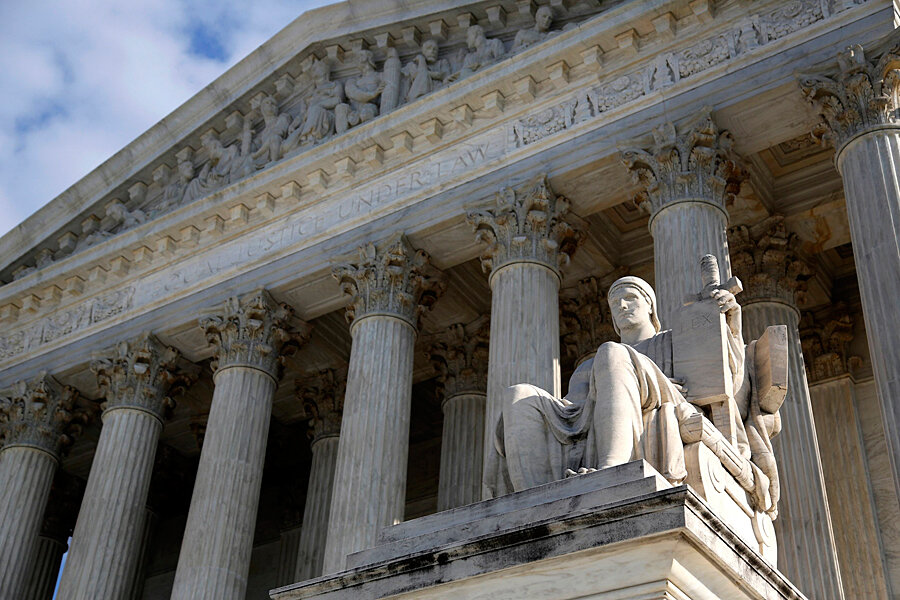Tea party and political buttons: Supreme Court declines Minnesota case
Loading...
The US Supreme Court on Monday declined to take up a case testing a Minnesota law that bans the wearing of buttons or clothing with messages that election officials deem too political to be worn within 100 feet of any polling place.
The justices took the action in a one-line order without comment. It lets stand a federal appeals court decision upholding the statute.
The Minnesota law seeks to prevent campaigning and electioneering by candidates and their supporters at the locations where voters are casting their ballots. But an array of conservative groups challenging the statute said it went far beyond preventing electioneering and violated the free speech rights of voters to express broader political ideas without facing government censorship.
The lawsuit was filed by various conservative political groups, including the Minnesota North Star Tea Party Patriots, that complained the law would prevent voters from wearing T-shirts proclaiming “Don’t Tread on Me” and buttons urging election officials to check voters’ identification.
“On its face, the contested Minnesota statute opposes all political content of apparel; thereby the Minnesota statute covers the universe of expressive activity,” Minneapolis lawyer Erick Kaardal wrote in his petition urging the court to take up the case.
“The government simply presumes that political speech on apparel automatically harms potential voters,” he said.
“Consequently, every Minnesotan who walks into a polling place, wearing clothes, is subject to prosecution if the clothes worn are viewed as ‘political,’ “ he said.
Violators could be fined up to $300.
A federal judge threw the lawsuit out, and a federal appeals court panel agreed. The Eighth Circuit Court of Appeals ruled 2 to 1 that polling places were not locations open for public debate so the government could justify some restrictions on free speech.
State officials say the statute barring political messages is a reasonable regulation of speech at a polling place. It imposes a neutral requirement that applies to everyone equally, they say.
In upholding the law, the Eighth Circuit panel said the statute was justified in restricting messages about any political campaign at a polling place.
The appeals court was less explicit about whether broad application of the statute to restrict noncampaign messages that do not seek to persuade or influence voters would also be justified. But the judges noted that other courts have upheld such broad bans on noncampaign-related speech.
The appeals court added: “Even if Minnesota acted unreasonably in applying the statute to some [noncampaign related] material, the complaint does not allege that there were a ‘substantial number’ of such unreasonable applications in relation to the statute’s reasonable applications.”
The dissenting judge on the three-judge panel noted that the Minnesota statute was designed to prevent disruptions and confusion at polling places.
“I fail to see how this broad restriction, which prohibits a voter from wearing any political emblem, insignia, or slogan that is unrelated to an issue or candidate on the ballot, would rationally and reasonably help maintain the ‘peace, order, and decorum’ of the polling place, ‘protect voters from confusion or undue influence,’ or ‘preserve the integrity of [Minnesota’s] election process,’ ” Judge Bobby Shepherd wrote.
He continued: “The record in this case is devoid of facts which demonstrate that any disruption of the ‘peace, order, and decorum’ of the Minnesota election process has occurred by virtue of voters wearing a political emblem, insignia, or slogan that is unrelated to any issue or candidate on the ballot.”
The appeals court dismissed the First Amendment challenge to the statute and said that any overbreadth of enforcement of the statute should be addressed on a case-by-case basis. That portion of the case was remanded for further consideration by the district court.
The challenge to the Minnesota law first arose in the run-up to the 2010 elections. A coalition of conservative political groups produced buttons that they intended to wear on Election Day. The groups supported voter ID laws.
The buttons said: “Please I.D. Me.” The groups also produced T-shirts and hats with tea party slogans including: “Don’t Tread on Me” and “We’ll Remember in November.”
Prior to the election, the groups asked a federal judge to invalidate a portion of the Minnesota law that banned the wearing of a political badge, button, or insignia at a polling place on Election Day.
The judge refused to block the law. Election officials responded to the legal challenge by enacting a policy that enforced a broad reading of the ban to prevent the wearing of the “Please I.D. Me” buttons, tea party T-shirts, and all other political messages.
During Election Day voting, at least three individuals were asked by poll officials to remove or cover their messages or face punishment.
In urging the high court to take up the issue, Mr. Kaardal wrote: “The Eighth Circuit’s decision ... eviscerates any protection of the right to self-expression in the polling place and requires all individuals to essentially wear colorless coveralls to avoid prosecution for wearing apparel the government, with unfettered discretion, deems political.”
“In a country in which all speech is ultimately politicized, the government can now proclaim that all political messaging on apparel ... is prohibited from the polling place,” Kaardal said.
“Wearing jewelry depicting a flag of any nation, of any religion, or symbolic of any organized group is now banned absolutely,” he said.
The case was Minnesota Majority v. Mansky (13-185).





